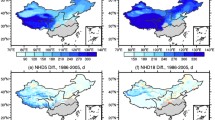Abstract
The minimum energy consumption in cities of the Russian Plain is largely determined by climatic conditions, because residential heating in winter is a vital necessity. Therefore, the specific heat demand (SHD)—an estimate for the climatically driven minimum energy demand for heating 1 m2 of living space—is proposed as an economically significant indicator of regional climate change. Calculated SHD values obtained from numerical experiments with the INM-CM5.0 climate model indicate a possible downward trend in SHD observed in cities of the Russian Plain in 1950–2014. The proposed indicator makes it possible to estimate the scale of the problem arising from the need to adapt urban energy systems to reduced energy consumption for heating, using data from numerical experiments with climate system models.


Similar content being viewed by others
REFERENCES
Heinimann, H.R. and Hatfield, K., in Resilience and Risk, Dordrecht: Springer, 2017.
Volodin, E. and Gritsun, A., “Simulation of observed climate changes in 1850–2014 with climate model INM-CM5,” Earth Syst. Dyn., 2018, vol. 9, no. 4, pp. 1235–1242.
Alexandrov, G.G., and Ginzburg, A.S., “Anthropogenic impact of Moscow district heating system on urban environment,” Energy Procedia, 2018, vol. 149, pp. 161–169.
Ginzburg, A.S., Reshetar’, O.A. and Belova, I.N., “Impact of climatic factors on energy consumption during the heating season,” Therm. Eng., 2018, vol. 63. no. 9, pp. 621–627.
Belova, I.N., Ginzburg, A.S., and Krivenok, L.A., “Heating seasons length and degree days trends in Russian cities during last half century,” Energy Procedia, 2018, vol. 149, pp. 373–379.
Spravochnoe posobie k SNiP 23-01-99 “Stroitel’naya klimatologiya” (Reference Manual to Construction Directives and Rules 23-01-99 “Construction Climatology”), Moscow: NIISF, 2006.
Alexandrov, G.G., and Ginzburg, A.S., in Proc. All-Russian Conf. “Climate Change: Causes, Risks, Consequences, and Adaptation and Regulation Problems. Climate-2019” (Moscow, 26–28 November 2019), p. 160.
GOST (State Standard) 56778-2015. Heat transfer systems for space heating. Methodology for calculating energy consumption and efficiency. http://docs.cntd. ru/document/1200127459
Nicol, J.F., and Humphreys, M.A. “Adaptive thermal comfort and sustainable thermal standards for buildings,” Energy Build., 2002, vol. 34, no. 6, pp. 563–572.
Sanitary Rules and Regulations 2.2.4.548-96. Hygienic requirements to the microclimate of production facilities. http://docs.cntd.ru/document/901704046
GOST (State Standard) 30494-2011. Residential and public buildings. Indoor microclimate parameters. http://docs.cntd.ru/document/gost-30494-2011
van Ruijven, B.J., De Cian, E., and Wing, I.S., “Amplification of future energy demand growth due to climate change,” Nat. Commun., 2019, vol. 10, no. 1, pp. 1–12.
Gidden, M., et al., “Global emissions pathways under different socioeconomic scenarios for use in CMIP6: a dataset of harmonized emissions trajectories through the end of the century,” Geosci. Model Dev. Discuss., 2019, vol. 12, no. 4, pp. 1443–1475.
Balaji, V., et al., “Requirements for a global data infrastructure in support of CMIP6,” Geosci. Model Dev., 2018, vol. 11, no. 9, pp. 3659–3680.
Eyring, V., et al., “Overview of the Coupled Model Intercomparison Project Phase 6 (CMIP6) experimental design and organization,” Geosci. Model Dev., 2016, vol. 9, no. 5, pp. 1937–1958.
Slivinski, L.C., et al., “Towards a more reliable historical reanalysis: Improvements for version 3 of the Twentieth Century Reanalysis system,” Q. J. R. Meteorol. Soc., 2019, vol. 145, no. 724, pp. 2876–2908.
Lawrimore, J.H., et al., “An overview of the Global Historical Climatology Network monthly mean temperature data set, version 3,” J. Geophys. Res.: Atmos., 2011, vol. 116, no. D19.
Huang, J., and Gurney, K.R., “Impact of climate change on US building energy demand: sensitivity to spatiotemporal scales, balance point temperature, and population distribution,” Clim. Change, 2016, vol. 137, nos. 1-2, pp. 171–185.
Hamlet, A.F., et al., “Effects of projected climate change on energy supply and demand in the Pacific Northwest and Washington State,” Clim. Change, 2010, vol. 102, nos. 1-2, pp. 103–128.
Sathaye, J.A., et al., “Estimating impacts of warming temperatures on California’s electricity system,” Global Env. Change, 2013, vol. 23, no. 2, pp. 499–511.
Xu, P., et al., “Impacts of climate change on building heating and cooling energy patterns in California,” 792–804.
Wang, H, and Chen, Q., “Impact of climate change heating and cooling energy use in buildings in the United States,” Energy Build., 2012, vol. 82, pp. 428–436.
Dirks, J.A., et al., “Impacts of climate change on energy consumption and peak demand in buildings: A detailed regional approach,” Energy, 2015, vol. 79, pp. 20–32.
Grealis, E., Musch, A.K., and Rau, H., in Energy Demand Challenges in Europe, Cham: Palgrave Pivot, 2019, pp. 21–33.
Livchak, V.I., Justification of the calculation of specific indicators of heat consumption for heating multi-storey residential buildings. www.abok.ru/for_spec/articles. php?nid=2782
Odysee-Mere. Consumption of household per m2 for space heating (at normal climate) www.indicators.odyssee-mure.eu/online-indicators.html
Berger, M., and Worlitschek, J., “The link between climate and thermal energy demand on national level: A case study on Switzerland,” Energy Build., 2019, vol. 202, pp. 109372. https://doi.org/10.1016/j.enbuild.2019.109372
Hausfather, Z. and Peters, G.P., “Emissions–the ‘business as usual’ story is misleading,” Nature, 2020, no. 577, pp. 618–620.
ACKNOWLEDGMENTS
This study was conducted under the scientific supervision of A.S. Ginzburg.
Funding
The study was supported by the Russian Science Foundation, project no. 16-17-00114.
Author information
Authors and Affiliations
Corresponding author
Additional information
Translated by V. Arutyunyan
Rights and permissions
About this article
Cite this article
Alexandrov, G.G. Climatically Driven Minimum of Energy Demand for Heating in Cities at the Center of the European Part of Russia. Izv. Atmos. Ocean. Phys. 56, 613–617 (2020). https://doi.org/10.1134/S000143382006002X
Received:
Revised:
Accepted:
Published:
Issue Date:
DOI: https://doi.org/10.1134/S000143382006002X




